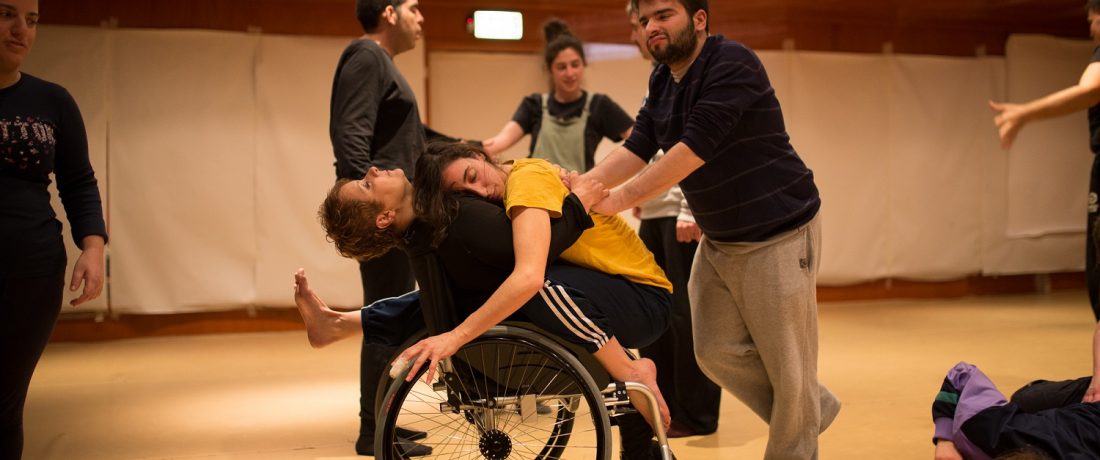
Group Improvisation
TARGET GROUP
Adults with mixed disabilitiesPARTICIPANTS
11DURATION
1 hour 15 minutesORGANIZATION
Holland Dance FestivalGoal - Essential question
Develop group creativity and spatial awareness.
Meeting the Group (10 minutes)
Sitting in a circle the dancers introduce themselves and answer the question whether there is anything the group needs to know before the dancing starts.
Outcomes: Creating a safe sharing space from the beginning of class in which the dancers feel they can share their needs and potential insecurities with the group.
Warm-Up (15 minutes)
Moving freely in space to music of our choice, we always try to move where there is an empty space. When the music stops, we freeze and look around to see how the space is divided between the dancers. The teacher asks the question, “if you could change one thing about your current position in space, what would it be?” and the dancers perform the change they invent. One dancer does not dance but observes the other dancers. When that dancer claps his/her hands, the group freezes. The “director” is asked to clap if they see something that triggers their eye and then has to name it when the group is frozen.
Outcomes: We get acquainted with the space and the group. We become aware of positive and negative general space. We take the lead and train our eye for spatial patterns.
The castle (18 minutes)
Phase A (10 minutes)
The dancers form a big circle in the space. One of the dancers calls out ‘1’ and forms a “statue” in the center of the circle. The next dancer calls out “2” and forms a statue in reaction to the first one made. All dancers come in until there is a full “castle” of statues. Then the teacher says “number 1” and dancer number one has to get out of the group of statues without the others changing anything about their posture. Number one now gets the chance to see the castle. Then number two is been called out etc.
Outcomes: We stimulate creativity and we react to other shapes in space. It is also a very fun game.
Phase B (8 minutes)
We build a castle again, but this time as if all the dancers were confined in the space of an elevator. Then we build a castle but we keep as far away from each other as possible; we build a castle on a diagonal line etc.
Outcomes: We build a sense of spatial “stretch” and at the same time we become comfortable with light physical contact.
Pathways (10 minutes)
All dancers place themselves on the periphery of the room. When the music starts, they find a pathway to a clear point they decide upon before starting to move. Once they arrive at the point, they pick another point to move towards that. The teacher then adds on an extra quality of movement about the pathway; angular, circular, as direct as possible, as indirect as possible etc.
Outcomes: We invent new ways of crossing the space, creating spatial patterns.
Stepping in (10 minutes)
Phase A (5 minutes before the exercise starts)
The dancers place themselves behind a line. This line limits the off-stage zone. Each dancer will come onto ‘the stage’ and will choose a spot, a direction of facing, and the duration of stay. Each dancer gets three goes.
Tip: a time is agreed upon so all dancers know how long they have to spend their three “goes”. This exercise can then be repeated in intervals of 3 minutes, 1 minute etc. We repeat several times.
Outcomes: We become aware of interesting spatial patterns and spatial timing.
Phase B (5 minutes)
The dancers that are off stage can now say “pause” at any time, and all the dancers on stage have to freeze. The dancers off stage imagine a name for the pattern they see in space. It can be a nice challenge to see if the dancers can later place themselves back in the formations that have been named.
Outcome: We develop group creativity and spatial awareness.
Group improvisation (5 minutes)
The dancers all start “off stage” and can choose when they want to move onto the stage. They are asked to have a clear spatial intention when they get on stage and then to let themselves be inspired by the changes made in space by the other dancers.
Outcomes: We bring all the other assignments together and integrate the technical elements in an improvisation.
Cooling down (5 minutes)
Sitting in a circle, the dancers take turns inventing a nice wind-down movement that the group repeats. We use soft melodic music.
Outcomes: We cool down.
